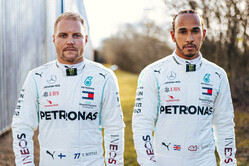 Toto Wolff: Spielberg didn't always yield the best results for us in recent years, so it feels good to head to Hungary with two victories and a lot of points. We put a lot of effort into finding reliability solutions between the races and it was an impressive team effort to deliver them in time. That was echoed by the strong work from the team at the track, all of which ultimately rewarded us with a 1-2 on Sunday.Both drivers did a good job last weekend. Lewis' pole lap in the rain was one of the best I've ever seen and his performance in the race was flawless. Valtteri had a harder time on Saturday, but his damage limitation on Sunday was successful.
Toto Wolff: Spielberg didn't always yield the best results for us in recent years, so it feels good to head to Hungary with two victories and a lot of points. We put a lot of effort into finding reliability solutions between the races and it was an impressive team effort to deliver them in time. That was echoed by the strong work from the team at the track, all of which ultimately rewarded us with a 1-2 on Sunday.Both drivers did a good job last weekend. Lewis' pole lap in the rain was one of the best I've ever seen and his performance in the race was flawless. Valtteri had a harder time on Saturday, but his damage limitation on Sunday was successful.
Two wins from two races might sound like the performance picture is clear, but that's far from the truth. We've only raced on a single track so far and it is way too early to make any assumptions. The next race in Hungary will be a different scenario and we're expecting a challenging fight. The Hungaroring has always suited Red Bull and they've shown their strength in the slow corners again this year, so they will be very hard to beat. Given the calendar changes this year, the Hungaroring is set to be the highest-downforce track in 2020, so it will be interesting to see whose aero package delivers the most at this track. The first two races this year have been highly entertaining and I'm looking forward to another exciting race weekend to conclude the first triple-header of the year.
Fact File
With the revised 2020 schedule and the circuit's relentless run of corners, the Hungaroring looks set to be the highest downforce track on the calendar.
Because of the track's high-downforce nature, its maximum speed - 318 km/h - is one of the lowest in F1.
F1 cars only spend around 10 seconds going in a straight line during a lap in Hungary, with the remaining 65 seconds or so spent cornering.
The Hungaroring only has 14 classified corners but is known for its constant cornering because many of its corners are long, low-speed or both. But in terms of the number of corners, only Monza and Spielberg have fewer.
Despite the Hungaroring having one of the shortest start/finish straights, the track has the fifth-longest run to Turn 1 from pole position - due to the grid being positioned very close to the exit of the final corner. Only Monza, Barcelona, Mexico City and Sochi have longer runs to Turn 1.
The circuit is one of the toughest for brake cooling, in part due to the lack of straights and often made worse by cars being stuck in traffic.
Just 65% of the lap distance at the Hungaroring is taken at full throttle, one of the lowest figures in F1. Singapore and Monaco are the only F1 venues with lower percentages.
The air and track temperatures experienced at the Hungarian Grand Prix are typically some of the highest of the season, with an average air temperature of 30°C and average track temperature of 49°C.
The average lateral G experienced during the course of the lap is one of the highest in F1, due to the grip levels from the new tarmac, long corners, lack of straights and high downforce levels.
The Hungaroring's kerbs are some of the most severe in F1 for the cars, although not to the same level as the kerbs in Austria. The spacing, height and speed at which drivers go over kerbs are all important factors. While the kerbs in Hungary are harsh, they are generally taken at slower speeds than in Spielberg.
The track features many long corners, some of which are 180 degrees or more, which impacts the suspension set-up. The majority of corners in Hungary are taken in "steady state", which is where the length of the corner allows the car to settle and stay in a rolled condition for a long period of time. A "transient state" means the opposite and is seen in corners requiring quick changes of direction. In Budapest, "steady state" is more important and the suspension can be tuned to be better suited to this.
The track layout of the Hungaroring makes overtaking notoriously difficult, especially in places without DRS. There was just one non-DRS overtake in 2019, the lowest figure of any race from last year, and 26 using DRS.
Lewis has won at the Hungarian Grand Prix seven times, making the Hungaroring his joint-most successful track - sharing the accolade with the Circuit Gilles Villeneuve in Montreal.
The 2009 Hungarian Grand Prix was the first race in F1 history to be won by a hybrid car. Back then, using the Kinetic Energy Recovery System (KERS) was optional and the opening races were won by cars with conventional engines. However, Mercedes-Benz had developed a hybrid system run by McLaren-Mercedes in 2009. So, when Lewis won the Hungarian Grand Prix on 26 July, it was the first ever victory for a hybrid Formula One car.






















sign in